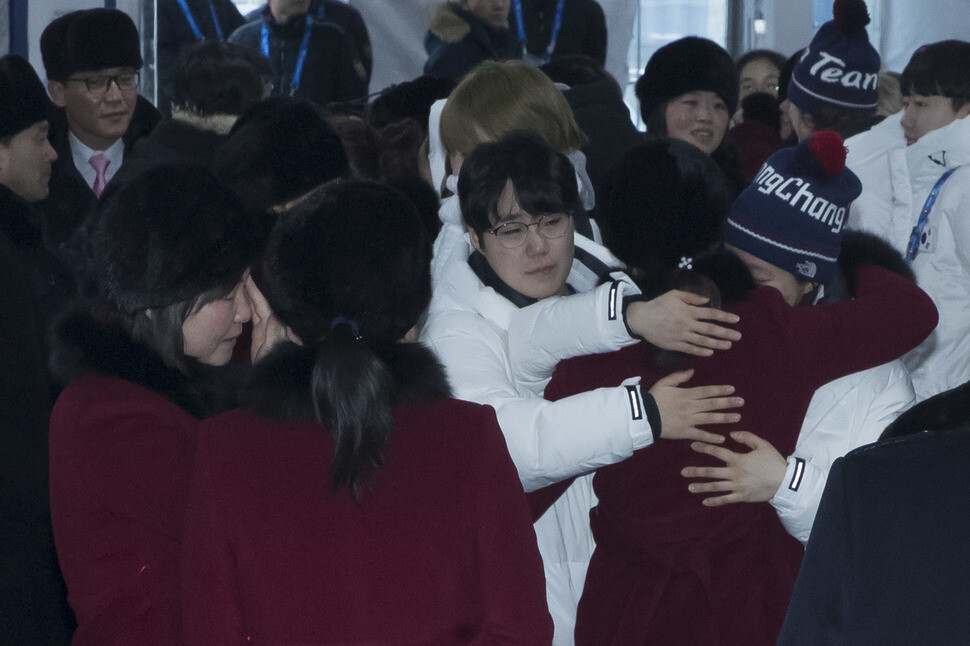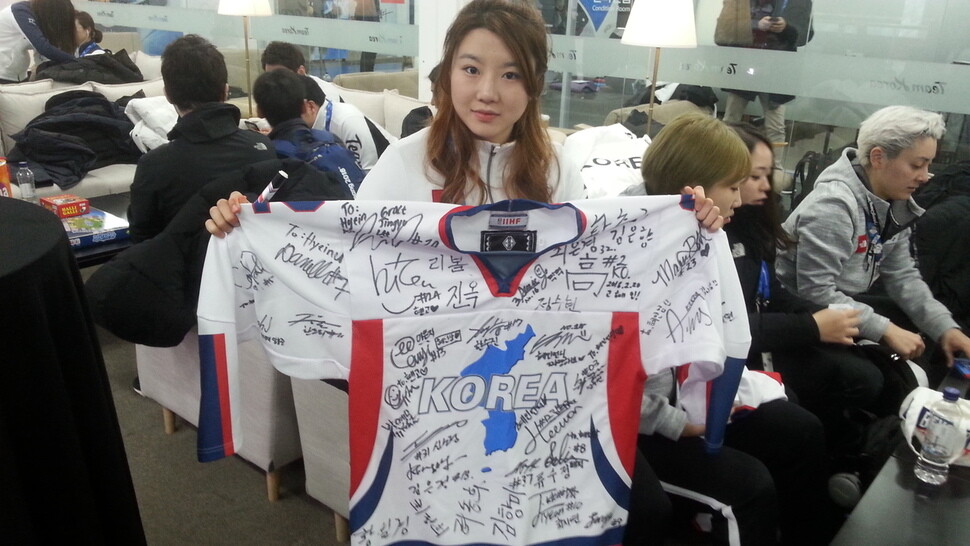hankyoreh
Links to other country sites 다른 나라 사이트 링크
Unified Korean women’s hockey team says a tearful goodbye

“Make sure to stay healthy. We should definitely meet up again.”
“Take care and see you someday.”
It was around 7:40 am on Feb. 26, and the welcome center in front of the Olympic athletes’ village in Gangneung was awash in tears. The bus was just 20 meters away, but it took the North Korean players on the unified women’s ice hockey team ten minutes to reach it. The South Korean athletes who had come to see them off embraced them tightly and would not let go. Team coach Sarah Murray and North Korean coach Pak Chol-ho also shared a tearful embrace. As they boarded the bus, the North Korean players opened the windows and reached their arms out to ease the pain of their goodbye.
“Who makes athletes cry? It’s just heartbreaking,” a Korea Ice Hockey Association (KIHA) official said.
On Feb. 23 and 24, the Hankyoreh visited Murray and the South Korean athletes at the Korea House in Gangneung’s Olympic Park to hear their fond memories of 33 days as a unified team.
When the 12 North Korean players first joined them at the Jincheon athletes’ village in North Chungcheong Province on Jan. 25, few truly understood how “peace” would become the 2018 Pyeongchang Olympics’ greatest legacy.
“The unified team was put together two weeks ahead of the Olympics, so there was a lot of concern,” Murray recalled.
But the unified Korean team proved the key driving force behind the Olympics’ success. The International Olympic Committee (IOC), which emphasizes the legacy of individual Olympics events, is certain to remember the Pyeongchang event as a “peace Olympics.” The puck used to score the team’s first goal in a Group B match against Japan is to be enshrined in the International Ice Hockey Federation (IIHF) Hall of Fame. Many foreign reporters could be seen cheering on the unified team members as they watched their matches.
Murray’s concerns about actually integrating the unified team proved needless. When the team’s Olympic journey finished on Feb. 20 with a loss in a seventh place classification match with Sweden, the players embraced and consoled each other; many of the athletes were also in tears at a Feb. 25 luncheon with Minister of Unification Cho Myoung-gyon.

“It didn’t take us long to become one”
“They’re all Koreans, and they share the same blood,” Murray said. “While there a bit of internal resistance at first, that all changed when we met these sweet and cheerful North Korean players. It didn’t take us long to become one.”
Player Jo Su-sie helped by translating Murray’s English into Korean for the benefit of the North Korean athletes.
“It was kind of a mess at first because of the different speaking styles and accents, but once I realized their genuineness, we were able to communicate emotionally,” Jo said.
Murray established trust by having the South and North Korean players eat together at the same tables, holding birthday parties, and treating everyone fairly. She also distributed a printout showing over 70 inter-Korean ice hockey terms so the South Korean players could learn the North Korean terminology and vice versa.
South Korean players Lee Eun-ji, Kim Hee-won, and Eom Su-yeon – all three 17-year-old high school students – said they “learned the North Korean players were different from our preconceptions.” The trio first met the North Korean team in Apr. 2017 at the IIHF World U18 Div. IIA Championship in Gangneung. Meeting the North Korean players at a buffet in the hotel where both teams were staying, there was a chill in the atmosphere.
Kim Hee-won, a defender for the unified team, explained, “Last year, we were cold even when they acted friendly. This time we were like sisters.” Forward Lee Eun-ji, who was sidelined from the competition by injury, recalled, “The North Korean players said I ‘looked funny.’ We played a lot of jokes on them.” Defender Eom Su-yeon remembered, “They were really sweet to me. They’d say, ‘You look terrible.’”
The unified team was not subject to controls by South and North Korean authorities. Officials were unable to invade the players’ living space they shared or prevent communication between the players, young women in their teens and twenties. Chong Su-hyon, a North Korean player who took one of Eom’s heavily struck pucks to the neck during the two sides’ match at last year’s World Championships, played a joke this time on the defender.
“Su-hyon pointed at her neck and said, ‘It got so swollen because of you that I couldn’t eat,’” Eom recalled. “I apologized again and said I hadn’t done it on purpose, and she just laughed.”

The players weren’t prevented from dancing together to loud music in the locker room ahead of matches, or talking about the ice hockey gold medal match at the 2014 Sochi Olympics.
For Park Yoon-jung, who was adopted by a US family as a baby, the encounter with the North Korean players was a unique experience.
“When I was first chosen for the South Korean team four years ago, I was an outsider,” Park remembered. “I thought the North Korean players might feel like outsiders as I had. I think that motivated me to work harder to be close with them, thinking about how difficult it would be for them to come to the South and join the team.”
“The memories of the Olympics are really vivid, like when the South and North Korean players tried to throw Coach Murray in the water at Gyeongpo Beach or when we all drank tea together at the cafe,” she said.
The unified team’s competitive capabilities remain a topic for examination. In their first Olympic appearance, they went 0-for-5 and finished in eighth place out of eight teams. Given the South and North Korean teams’ respective world rankings of 22nd and 25th, the distance from the teams ahead was to be expected. So what did the team’s coach think of its abilities?
“When the 12 North Korean players joined the South Korean team, it changed the mood for a national team that was lacking a sense of competitiveness,” Murray said. “It brought a real sense of concern – the feeling that we needed to survive – which I think was a positive.”
During the unified team’s matches, three to four North Korean players took the ice per match, with the remaining positions filled by South Korean players.
Murray, who drew much global attention direction the unified team, is to continue coaching the South Korean team for the next two years. The number of teams competing at the 2022 Winter Olympics in Beijing may be increased to 12 from its current eight. The KIHA is working on a project to help the team qualify for those Games. But qualifying for the Olympics will not be easy for South Korea, and the fielding of another unified team hinges on variables in inter-Korean relations. Still, Murray maintained that she “learned a lot from integrating and training the two sides’ players.”
“Any time North Korea invites me, I’m willing to go and manage a short-term program for the players on their national team,” she said.
Murray named “munjigi,” (“goalkeeper”) as the most memorable North Korean expression she heard while coaching the unified team. She laughed as she pronounced the word in Korean. As her favorite word learned while living in South Korea, she gave “geobugi”, which means “turtle.” Perhaps the unified women’s ice hockey team she led will mark the turtle’s first step in the long journey to ending antagonisms between South and North.
By Kim Chang-keum and Kim Seong-gwang, staff reporters
Please direct questions or comments to [english@hani.co.kr]

Editorial・opinion
![[Column] Park Geun-hye déjà vu in Yoon Suk-yeol [Column] Park Geun-hye déjà vu in Yoon Suk-yeol](https://flexible.img.hani.co.kr/flexible/normal/500/300/imgdb/original/2024/0424/651713945113788.jpg) [Column] Park Geun-hye déjà vu in Yoon Suk-yeol
[Column] Park Geun-hye déjà vu in Yoon Suk-yeol![[Editorial] New weight of N. Korea’s nuclear threats makes dialogue all the more urgent [Editorial] New weight of N. Korea’s nuclear threats makes dialogue all the more urgent](https://flexible.img.hani.co.kr/flexible/normal/500/300/imgdb/original/2024/0424/7317139454662664.jpg) [Editorial] New weight of N. Korea’s nuclear threats makes dialogue all the more urgent
[Editorial] New weight of N. Korea’s nuclear threats makes dialogue all the more urgent- [Guest essay] The real reason Korea’s new right wants to dub Rhee a founding father
- [Column] ‘Choson’: Is it time we start referring to N. Korea in its own terms?
- [Editorial] Japan’s rewriting of history with Korea has gone too far
- [Column] The president’s questionable capacity for dialogue
- [Column] Are chaebol firms just pizza pies for families to divvy up as they please?
- [Column] Has Korea, too, crossed the Rubicon on China?
- [Correspondent’s column] In Japan’s alliance with US, echoes of its past alliances with UK
- [Editorial] Does Yoon think the Korean public is wrong?
Most viewed articles
- 1‘We must say no’: Seoul defense chief on Korean, USFK involvement in hypothetical Taiwan crisis
- 2N. Korean delegation’s trip to Iran shows how Pyongyang is leveraging ties with Moscow
- 346% of cases of violence against women in Korea perpetrated by intimate partner, study finds
- 4[Column] Park Geun-hye déjà vu in Yoon Suk-yeol
- 5‘Weddingflation’ breaks the bank for Korean couples-to-be
- 6Will NewJeans end up collateral damage in internal feud at K-pop juggernaut Hybe?
- 7Amnesty notes ‘erosion’ of freedom of expression in Korea in annual human rights report
- 8[Interview] Dear Korean men, It’s OK to admit you’re not always strong
- 9Korean government’s compromise plan for medical reform swiftly rejected by doctors
- 10[Editorial] Japan’s rewriting of history with Korea has gone too far